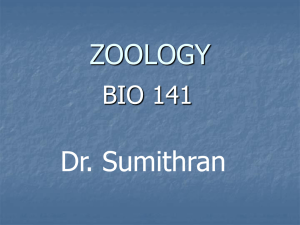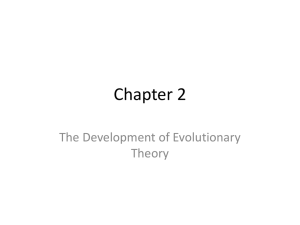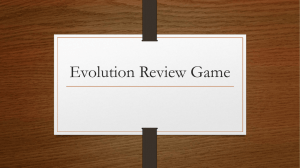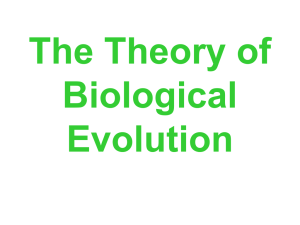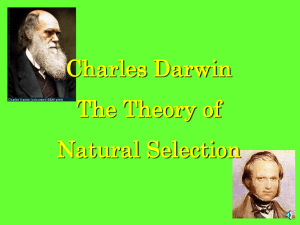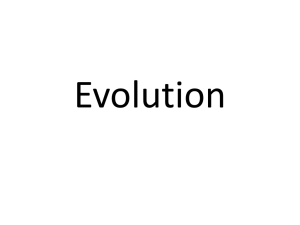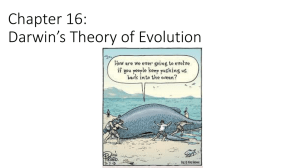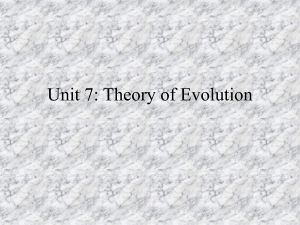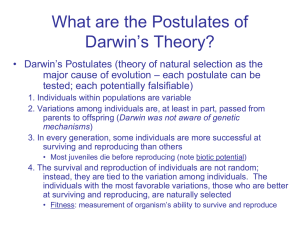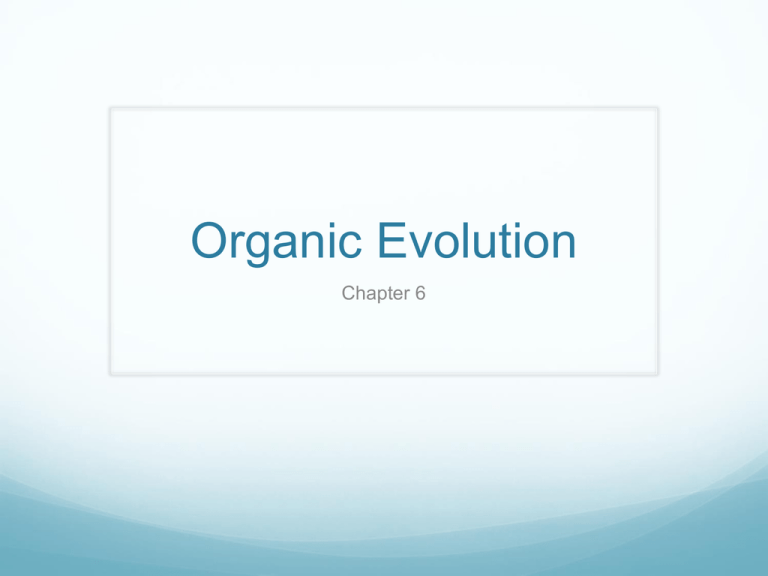
Organic Evolution
Chapter 6
Evolution - Defined
Evolution – a change in the genetic
composition of a population over time.
A change in the frequency of certain alleles.
On a larger scale, evolution can be used to
refer to the gradual appearance of all biological
diversity.
Darwin’s Revolutionary
Theory
The Origin of
Species focused
attention on the
diversity of life,
similarities as well
as differences, and
the adaptations
organisms have for
particular
environments.
Darwin’s Revolutionary
Theory
Charles Darwin
presented evidence
that many modern
organisms are
descended from
ancestral species
that were different.
Darwin’s Revolutionary
Theory
Prevailing view of the world was that the Earth
was only a few thousand years old and that all
life had been created at the beginning and
remained unchanged.
Pre-Darwinian Evolutionary Ideas
Several ancient Greek philosophers thought life
changed through time.
Aristotle recognized fossils as forms of ancient
life.
He developed the scala naturae (scale of nature).
Each form of life had a rung on the ladder.
Organisms were arranged in order of complexity.
The ancient Greeks didn’t propose an
evolutionary mechanism.
Pre-Darwinian Evolutionary Ideas
Lamarck was the
first to suggest an
explanation for
evolution.
Inheritance of
acquired
characteristics
Didn’t hold up to
testing.
A Mechanism for Evolution
Darwin presented a mechanism for evolution
– natural selection.
Organisms that are in some way more successful at
reproduction will pass on more of their genes.
Over time the traits responsible for that success will
become widespread in the population.
This theory holds up very well!!
Alfred Russell Wallace
Wallace independently
developed a theory of
natural selection.
He sent his manuscript to
Darwin, spurring him to
finally publish his ideas.
Both ideas were
presented to the Linnean
Society in 1858.
Darwin finished On the
Origin of Species and
published it in 1859.
Uniformitarianism
Charles Lyell’s
principle of
uniformitarianism:
Laws of physics &
chemistry present
throughout history
of Earth.
Past geological
events similar to
today’s events.
Principles of
Geology
Uniformitarianism
Natural forces could
explain the
formation of fossilbearing rocks.
Lyell concluded the
age of the earth
must be millions of
years.
He stressed the
gradual nature of
geological changes.
Uniformitarianism and the Age of
Earth
Darwin studied the work of Lyell closely. He
took the first volume of Lyell’s Principles of
Geology on the Beagle. He received the
second volume while on the voyage.
He concluded that Earth must be much older than
6000 years.
Perhaps these slow changes could work on living
things as well…..
Evolution in Need of a Mechanism
Darwin was not the first to have the thought
that organisms change through time.
His grandfather, Erasmus Darwin, and others
suggested that life evolves as environments change.
But a mechanism for that change was needed.
Darwin (1809 – 1882)
Darwin had a
lifelong love of
nature.
His father wanted
him to study
medicine.
This was not what
Darwin wanted and
he didn’t finish.
Darwin
After leaving medical school he attended
Cambridge University with the intention of
entering the clergy.
His mentor and botany professor, John
Henslow, recommended him for a position as
ship’s naturalist aboard the Beagle.
The Voyage of the Beagle
Darwin started out on a five year trip around the
world aboard the Beagle in 1831. He was 22.
As ship’s naturalist he spent his time on shore
collecting thousands of plant and animal
specimens and making important observations.
The Voyage of the Beagle
Darwin saw that the plants and animals that he
found in temperate areas of South America
were more similar to tropical South American
species than they were to temperate European
species.
The Voyage of the Beagle
The fossils he found in South America were
more like modern South American species than
European species.
The Voyage of the Beagle
During the voyage he read Lyell’s Principles of
Geology.
He had Lyell’s ideas in mind as he traveled and
observed the geology of South America.
The Voyage of the Beagle
He experienced an earthquake in Chile and
observed that the coastline had risen several
feet.
He also found marine fossils high in the Andes
Mountains.
Darwin concluded that the mountains were
formed by a series of such earthquakes.
The Voyage of the Beagle
Darwin became interested in the geographic
distribution of organisms after visiting the
Galapagos Islands.
After the Voyage
After returning, Darwin
realized that
adaptation to the
environment and the
origin of new species
were closely linked
processes.
Galapagos finch
species have evolved
by adapting to specific
conditions on each
island.
Natural Selection
After reading a paper by
Thomas Malthus
concerning the fact that
human populations
increase faster than
limited food resources,
Darwin noticed the
connection between
natural selection and
this ability of
populations to
overreproduce.
Natural Selection
Only a small fraction of all offspring produced
by any species actually reach maturity and
reproduce.
Natural populations normally remain at a
constant size.
Natural Selection
Those that survive may have heritable traits
that increased their chances of survival.
They will pass those traits on.
The frequency of those traits will increase.
Artificial Selection
Artificial selection
– people selectively
breed organisms
with desired traits.
Darwin noticed that
considerable
change can be
achieved in a short
period of time.
Natural Selection
Natural selection occurs when organisms with
particular heritable traits have more offspring
that survive & reproduce.
Natural Selection
Natural selection
can increase the
adaptation of an
organism to its
environment.
Natural Selection
When an environment changes, or when
individuals move to a new environment, natural
selection may result in adaptation to the new
conditions.
Sometimes this results in a new species.
Natural Selection
Individuals do not evolve; populations evolve.
Evolution is measured as changes in relative
proportions of heritable variations in a
population over several generations.
Natural Selection
Natural selection can only work on heritable
traits.
Acquired traits are not heritable and are not subject
to natural selection.
Natural Selection
Environmental factors are variable.
A trait that is beneficial in one place or time may be
detrimental in another place or time.
Darwinian Evolutionary Theory:
Evidence
The main premise underlying evolutionary
theory is that the living world is always
changing.
Perpetual change in form & diversity of
organisms over the last 700 million years can
be clearly seen in the fossil record.
Fossils
Fossils are remnants of
past life preserved in the
earth.
Complete remains –
insects in amber.
Petrified skeletal parts
infiltrated with silica or
other minerals.
Or traces of organisms
such as molds, casts,
impressions, trackways,
or fossilized excrement.
The Fossil Record
Fossils provide support
for the idea that life
changes through time.
Fossil intermediates
Whales descended
from land mammals.
Birds descended from
one branch of
dinosaurs.
The oldest fossils are
of prokaryotes.
Dating Fossils
Geological time can be measured in
sedimentary rock layers.
The Law of Stratigraphy
Dates oldest layers at the bottom and youngest at
the top.
Time is divided into eons, eras, periods and
epochs.
Dating Fossils
Radiometric dating methods are based on the
decay of naturally occurring elements into other
elements.
Different methods used for different time
periods.
Dating Fossils - example
has a half life of 1.3 billion years – meaning
half of the 40K will have decayed to 40Ar and
40Ca. Half of what remains will decay in the
next 1.3 billion years.
40K
Measure ratio of remaining 40K to the amount
of 40K originally there (remaining
and 40Ca).
40K
plus 40Ar
Fossil Record
The fossil record of
macroscopic organisms
begins in the Cambrian
period: 505–570 MYA.
Fossil bacteria and
algae, casts of
jellyfishes, sponges
spicules, soft corals, and
flatworms are found in
Precambrian rocks.
Mostly microscopic
Evolutionary Trends
The fossil record shows that species arise and
go extinct repeatedly throughout geological
history.
Trends appear in the fossil record – directional
changes in features or patterns of diversity.
Evolutionary Trends
The evolution of horses
from the Eocene epoch
(57.8 MYA) to the
present is a well
studied trend.
Body size – increasing
Foot structure – fewer
toes
Tooth structure – larger
grinding surface
Common Descent
Darwin proposed that all organisms have
descended from a single ancestral form.
Life history is shown as a branching tree called
a phylogeny.
Homology
The phrase “descent with modification”
summarizes Darwin’s view of how Evolution
works.
All organisms descended from common ancestor.
Similar species have diverged more recently.
Homology – when similar structures result
from shared ancestry.
Anatomical Homologies
Homologous structures – variations on a
structural theme that was present in a common
ancestor.
Example – vertebrate forelimbs have different
functions, but share the same underlying structure.
Anatomical Homologies
Vertebrate embryos have a tail and pharyngeal
pouches.
These structures develop into different but
homologous structures in adults.
Gills in fishes
Part of ears & throat in humans.
Ontogeny & Phylogeny
There are many parallels between ontogeny
(an individual’s development) and phylogeny
(evolutionary descent).
Embryological similarities
Features of an ancestors ontogeny can be shifted
earlier or later in a descendant's ontogeny.
Ontogeny & Phylogeny
Heterochrony – evolutionary
change in timing of
development.
Characteristics can be added
late in development and
features are then moved to an
earlier stage.
Ontogeny can be shortened in
evolution.
Terminal stages may be
deleted causing adults of
descendants to resemble
youthful ancestors.
Paedomorphosis
Retention of ancestral
juvenile characters by
descendant adults.
Developmental Modularity and
Evolvability
Heterotopy – a change in the physical
location of a developmental process in an
organism’s body.
Process must be compartmentalized into semiautonomous modules to be expressed in new
location
Ex: Location of toepad development in geckos.
Developmental Modularity and
Evolvability
Evolvability – denotes the great evolutionary
opportunities created by semi-autonomous
developmental modules whose expression can
be moved from one part of the body to another.
Allows for “experimentation” with the construction
of many new structures.
Vestigial Organs
Vestigial organs – remnants of structures that
served important functions in an ancestor.
Remnants of pelvis and leg bones in snakes
Appendix in humans
Molecular Homologies
Similarities can be found at the molecular level,
too.
The genetic code is universal - it is likely that all
organisms descended from a common ancestor.
Different organisms share genes that have been
inherited from a common ancestor.
Often, these genes have different functions, like
the mammalian forelimbs.
Homologies & the Tree of Life
Darwin’s evolutionary tree of life can explain
homologies.
The genetic code is shared by all species because it
goes back deep into the ancestral past.
More recent homologies are shared by only smaller
branches of the tree.
Homologies & the Tree of Life
Homologies result in
a nested pattern.
All life shares the
deepest layer.
Each smaller group
adds homologies to
those they share
with larger groups.
Speciation
Speciation refers to the formation of new
species.
Defining a species is difficult…
Descent from common ancestral population.
Ability to interbreed.
Maintenance of genotypic & phenotypic cohesion.
Reproductive barriers prevent species from
interbreeding.
Where do they come from?
Allopatric Speciation
Allopatric (another land) populations occupy
separate geographic areas.
Separated geographically, but able to interbreed if
brought together.
Over time, reproductive barriers may evolve so
that they could not interbreed.
Allopatric speciation
Allopatric Speciation
The geographical separation can arise in two
ways:
Vicariant speciation is initiated when climatic or
geological changes fragment a species’ habitat,
forming impenetrable barriers.
Founder events occur when a small number of
individuals disperse to a distant place where no
other members of their species exist.
Hybrids
Much can be
learned by studying
what happens when
previously isolated
populations come
into contact again.
Hybrids are
offspring of
members of two
closely related
species.
Hybrids
Species eventually become different enough
that they can’t produce hybrids.
Premating barriers prevent mating from occurring in
the first place.
Postmating barriers impair growth, survival, or
reproduction of the offspring.
Sympatric Speciation
Sympatric (same land) speciation occurs when
speciation occurs in one geographic area – a lake for
example.
Individuals within the species become specialized on a
food type, shelter, part of the lake etc.
Eventually reproductive barriers evolve.
Parapatric Speciation
Parapatric Speciation – geographically
intermediate between allopatric and sympatric
speciation.
Two species are parapatric if their geographic
ranges are primarily allopatric but make contact
along a borderline that neither species successfully
crosses.
Adaptive Radiation
Adaptive radiation – the production of
ecologically diverse species from a common
ancestral stock.
Common in lakes & islands – sources of new
evolutionary opportunities.
Adaptive Radiation
Archipelagoes increase opportunities for both
founder events and ecological
diversification.
Entire archipelago isolated from the continent.
Each island is geographically isolated from the others.
Ex: Galápagos Islands
Gradualism
Darwin’s theory of
gradualism proposes
that small differences
accumulate over time
producing the larger
changes we see over
geologic time.
Certainly, this process
is always at work, but
probably does not
account for all
changes.
Punctuated Equilibrium
Punctuated
equilibrium states
that phenotypic
evolution is
concentrated in
relatively brief
events of branching
speciation followed
by periods of stasis.
Populations Evolve
Variation exists within
any population.
When natural
selection acts to favor
one trait over another
that trait will increase
in the population.
The population has
evolved, not any one
individual.
The Modern Synthesis
Population Genetics – the study of how
populations change over time.
Dependent on both Darwin’s theory of natural
selection and Mendel’s laws of inheritance.
All heritable traits have a genetic basis, some are
controlled by multiple genes – not as simple as in
Mendel’s studies.
The Modern Synthesis
The modern synthesis is a comprehensive
theory of evolution that brings in ideas from
many fields.
R. A. Fisher (statistician)
J. B. S. Haldane (biologist)
Theodosius Dobzhansky (geneticist)
Sewall Wright (geneticist)
Ernst Mayr (biogeographer)
George Gaylord Simpson (paleontologist)
G. Ledyard Stebbins (botanist)
Populations
Population – a localized, interbreeding group
of individuals of a particular species.
Separate populations of a species may be isolated
from each other.
Populations
Sometimes the
populations overlap,
but little
interbreeding
occurs.
Microevolution
Microevolution – evolutionary changes in the
frequency of alleles in a population.
Polymorphism – occurrence of different allelic
forms of a gene in a population.
If there is only one allele for a gene in the population
– every individual is homozygous for the trait – it is
fixed in the population.
All alleles of all genes possessed by all members of
a population form a gene pool.
Microevolution
Population geneticists measure the relative
frequencies of alleles in the population.
Allelic frequency
Genetic Equilibrium
According to Hardy-Weinberg equilibrium,
the hereditary process alone does not produce
evolutionary change.
Allelic frequency will remain constant generation to
generation unless disturbed by mutation, natural
selection, migration, nonrandom mating, or genetic
drift.
Sources of microevolutionary change.
Frequency of Alleles
Each allele has a frequency (proportion) in the
population.
Example population of 500 wildflowers.
CRCR = red; CRCW = pink; CWCW = white
320 red, 160 pink, 20 white
Frequency of CR =
(320 x 2) + 160 / 1000 = 800/1000 =.8 = 80%
Frequency of Alleles
p is the frequency of the most common allele
(CR in this case).
p = 0.8 or 80%
q is the frequency of the less common allele
(CW in this case).
p+q=1
q = 1- p = 1 – 0.8 = 0.2 or 20%
Hardy-Weinberg Theorem
Populations that are
not evolving are said
to be in HardyWeinberg
equilibrium.
As long as Mendel’s
laws are at work, the
frequency of alleles
will remain
unchanged.
Hardy-Weinberg Theorem
The Hardy-Weinberg theorem assumes
random mating.
Generation after generation allele frequencies
are the same.
Hardy-Weinberg Theorem
At a locus with two alleles, the three genotypes
will appear in the following proportions:
(p + q) x (p + q) = p2 + 2pq + q2 = 1
Hardy-Weinberg Theorem
Conditions:
Very large population
No gene flow into or out of the population
No mutations
Random mating
No natural selection
Departure from these conditions results in
evolution.
Practice with Hardy Weinberg
Hardy & Weinberg studied the frequencies of
alleles in populations.
Frequency – the proportion of individuals in a
category in relation to the total number of individuals.
100 cats, 84 black, 16 white – frequency of black =
84/100 = 0.84, white =0.16.
Two alleles – p is common, q is less common.
p+q = 1
Practice with Hardy Weinberg
(p + q)2 =
p2
+
Individuals
homozygous
for allele B
2pq +
Individuals
heterozygous
for alleles B
&b
q2
Individuals
homozygous
for allele b
Practice with Hardy Weinberg
Used to calculate allele frequencies (p & q) in a
simple way.
100 cats, 16 white (bb) so q2 = 0.16
q = square root of 0.16 = 0.40.
Since p + q = 1; p = 1 – q = 0.60.
p2 = 0.36; so 36 homozygous dominant (BB)
2pq = 0.48; 48 heterozygous (Bb)
Where Does Variation Come From?
Natural selection acts on the variation that is
already present in the population.
But, where did that variation come from?
Where Does Variation Come From?
Two processes provide the variation in gene
pools.
Mutation
Sexual recombination
Mutation
New genes or
alleles only result by
mutations.
Mutations are
changes in the
nucleotide sequence
of DNA.
Point Mutations
Point mutation – a change in a single base
pair.
Often harmless
Much of the DNA does not code for protein products.
Genetic code is redundant.
CGU, CGA, CGC, CGG all code for argenine.
Occasionally significant
Sickle cell disease.
Mutations
Beneficial mutations of any kind are very rare.
Mutations that alter gene number or sequence
are almost always harmful.
Gene Duplication
Gene duplication occasionally provides an
expanded genome with new loci that may take
on new functions as selection continues.
New genes can also appear when non-coding
introns get shuffled into the coding portion of
the genome.
Sexual Recombination
Sexual recombination is a much more
common way of producing variation in
populations.
Reshuffling of allele combinations already present in
the population is how variation is maintained in
populations.
Sexual reproduction rearranges alleles into fresh
combinations every generation.
Natural Selection
When natural selection is occurring, some
individuals are having better reproductive
success than others.
Alleles are being passed to the next generation in
frequencies that are different from the current
generation.
Hardy-Weinberg equilibrium is upset.
Genetic Drift
The smaller the sample, the greater the chance
of deviation from expected results.
These random deviations from expected
frequencies are called genetic drift.
Allele frequencies are more likely to deviate from the
expected in small populations.
Genetic Drift
Which allele was lost is due to random chance.
Over time, drift tends to reduce genetic
variation through random loss of alleles.
The Bottleneck Effect
Sometimes a
catastrophic event
can severely reduce
the size of a
population.
The random
assortment of
survivors may have
drastically different
allele frequencies.
Bottleneck effect
The Bottleneck Effect
The actions of people
sometimes cause
bottlenecks in other species.
N. California elephant seal
population reduced to 20100 individuals in the 1890s.
Current population >
30,000.
Variation drastically reduced
– 24 genes with 1 allele.
http://www.sealexperience.com/index.html
The Founder Effect
Founder effect – When a small group of
individuals becomes separated from the
population and form a new population, the
allele frequencies in their gene pool may be
different than the original population.
Gene Flow
The population can gain or lose new alleles
through gene flow.
When individuals move into or out of a
population, they may carry the only copy of
certain alleles in the gene pool with them.
Gene flow usually reduces differences between
populations.
Natural Selection &
Adaptation
Natural selection is the only one of these ways
of altering the gene pool that results in
adaptation.
Selection depends on variation.
Genetic Variation
Variation in a population is always present.
Heritable variation is the raw material of natural
selection.
Genetic Variation
Not all genetic variation is heritable.
Environmental influences sometimes effect
phenotype.
Polymorphism
Different versions of
discrete characters
are called morphs.
When a population
has two or more
morphs that are
common in the
population, it is
called polymorphic.
This is phenotypic
polymorphism
Protein Polymorphism
Different allelic forms of a gene code for slightly
different proteins – protein polymorphism.
If the difference affects the protein’s net
electric charge, the different forms can be
separated using protein electrophoresis.
Quantitative Variation
Quantitative traits are those that show
continuous variation.
Influenced by many genes.
Height in humans, tail length in mice
When trait values for a population are graphed, they
follow a bell shaped curve.
Modes of Selection
Stabilizing –
removes the
extremes.
Directional –
variants at one of
the extremes are
favored.
Disruptive –
variants at both
extremes are
favored.
Evolutionary Fitness
Fitness – the contribution an individual makes
to the gene pool of the next generation.
Relative fitness – the contribution of one
genotype relative to the contribution of other
genotypes at the same locus.
Natural selection acts on phenotypes.
Preserving Variation
Some variation is hidden from the natural
selection process in the form of recessive
alleles in heterozygotes.
Less favorable recessive alleles can be
maintained in the population because they do
not harm heterozygous individuals.
Sexual Selection
Sexual selection –
natural selection for
mating success.
May result in
sexual
dimorphism –
differences between
the sexes.
Secondary sexual
characteristics – not
directly involved in
reproduction.
Intrasexual Selection
Intrasexual selection – selection within the
same sex – results when individuals of one sex
are competing with each other for members of
the other sex.
Features that make the male a better fighter
or more intimidating to other males would be
favored.
Intersexual Selection
Intersexual
selection – mate
choice – individuals
of one sex are
choosy in selecting a
mate.
Features that make
an individual more
attractive to the
opposite sex would
be favored.
Intersexual Selection
Showiness that results from mate choice can
be risky.
Flashy tails of guppies make them more visible to
predators.
Benefits of finding a mate outweigh potential
costs.
Showiness may reflect overall health.
Macroevolution
Macroevolution refers to grand scale events in
evolution.
Evolution of new structures
Major trends in the fossil record
Gould’s Tiers of Time
Stephen Jay Gould
recognized three tiers of
time for evolutionary
processes:
Tens to thousands of
years – population
genetic processes.
Millions of years –
speciation and
extinction can be
measured and
compared among
different groups of
organisms.
Tens to hundreds of
millions of years –
marked by episodic
mass extinctions.
Speciation and Extinction
Through Geological Time
A species has two possible fates:
Become extinct or
Give rise to new species.
Speciation and extinction rates vary among
species.
Lineages with high speciation and low
extinction produce the greatest diversity.
Speciation and Extinction
Through Geological Time
Species Selection
Differential survival and multiplication of species
based on variation among lineages.
Species-level properties include mating rituals, social
structuring, migration patterns, geographic
distribution, etc.
Mass Extinctions
Mass extinctions are episodic events where
many species go extinct at the same time.
Permian extinction – 225 MYA – half the families of
shallow-water marine invertebrates and 90% of the
marine invertebrate species went extinct over a few
million years.
Cretaceous extinction – 65 MYA – marks the end of
the dinosaurs as well as many other species.
Mass Extinctions
Many possible
explanations for mass
extinctions have been
suggested.
Alvarez hypothesis –
bombardment of the earth
by asteroids would send
debris into the atmosphere,
altering climate.
Search for evidence
Craters
Atypical iridium
concentrations
Mass Extinctions
Catastrophic species selection would result
from selection by these events.
Mammals were able to use resources due to
dinosaur extinction.
Endurance of Darwin’s Theory
The beauty of Darwin’s theory is that it explains
so many different kinds of observations:
anatomical and molecular homologies that
match patterns in space (biogeography) and
time (fossil record).
"Nothing in biology makes sense except in the light of evolution." Theodosius Dobzhansky, Geneticist

